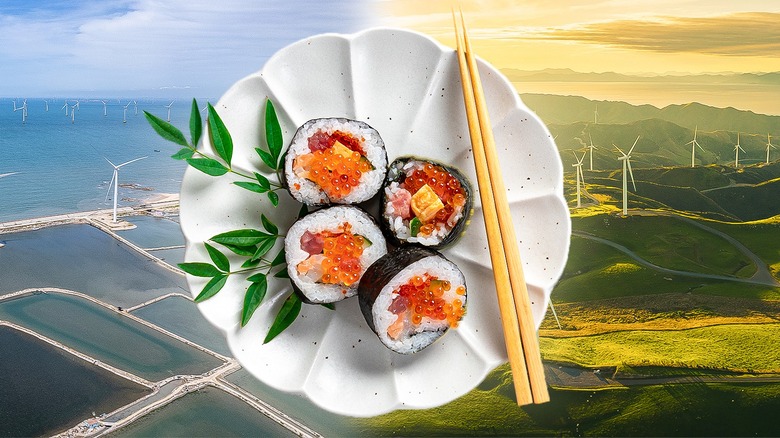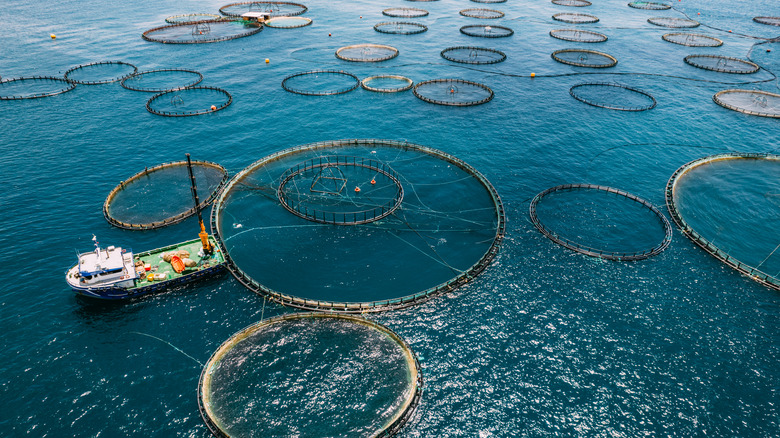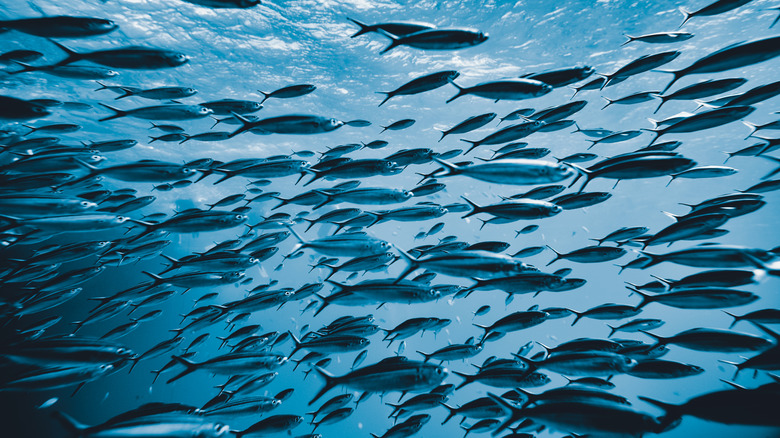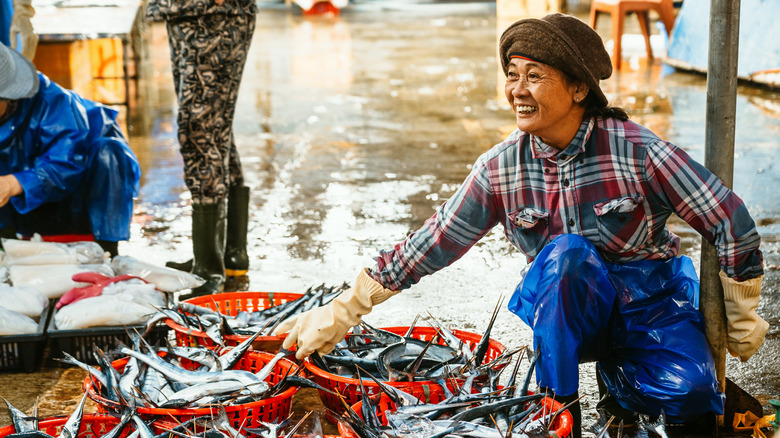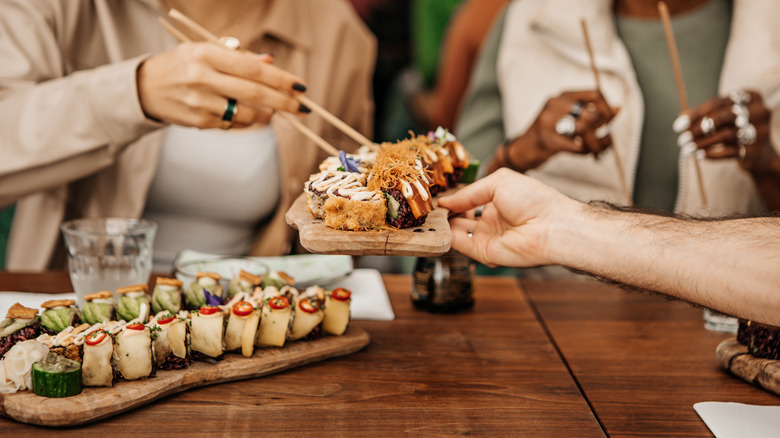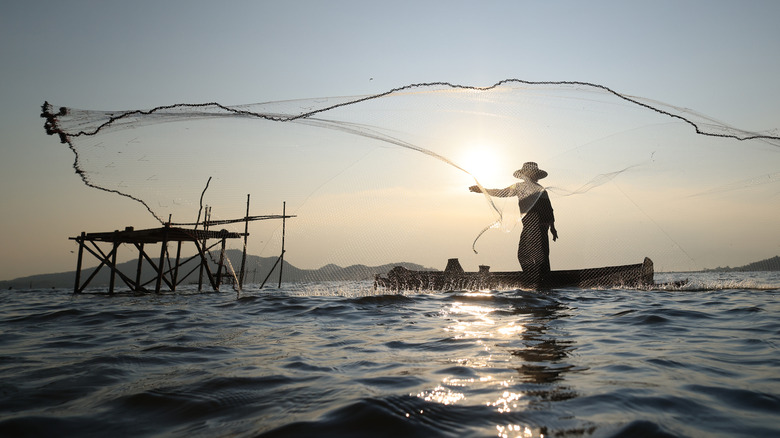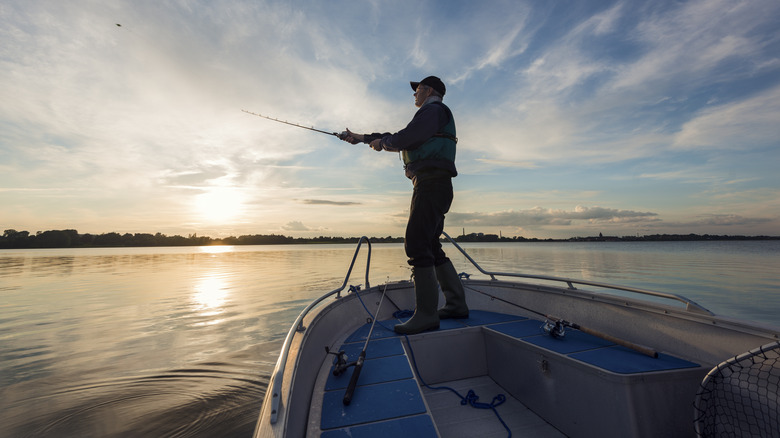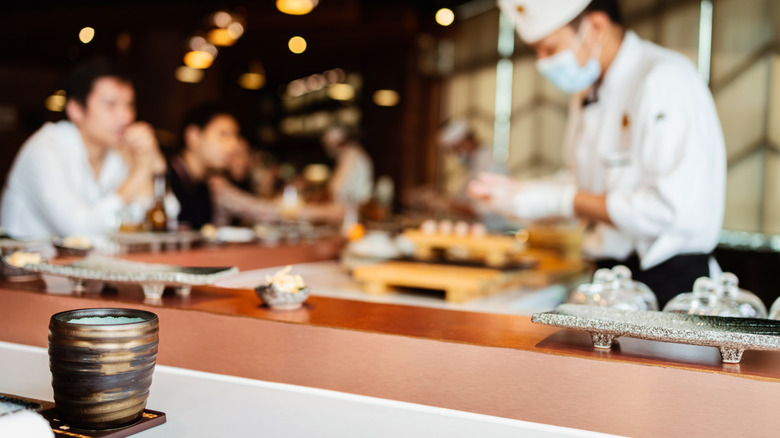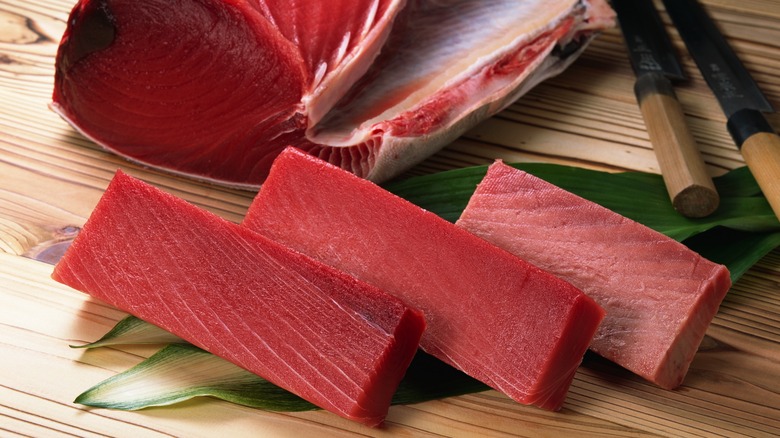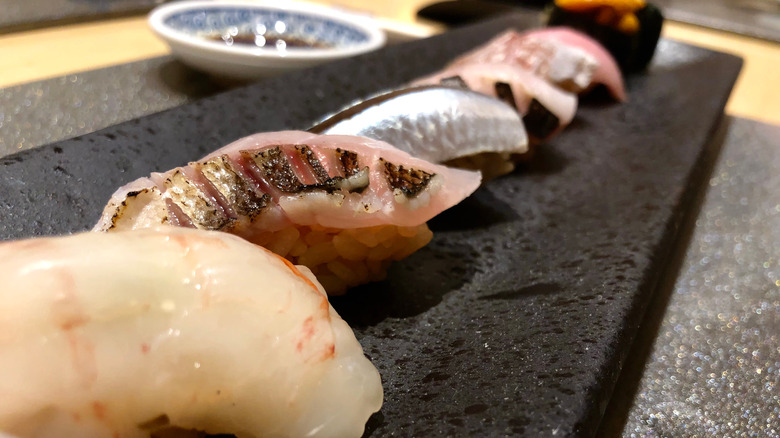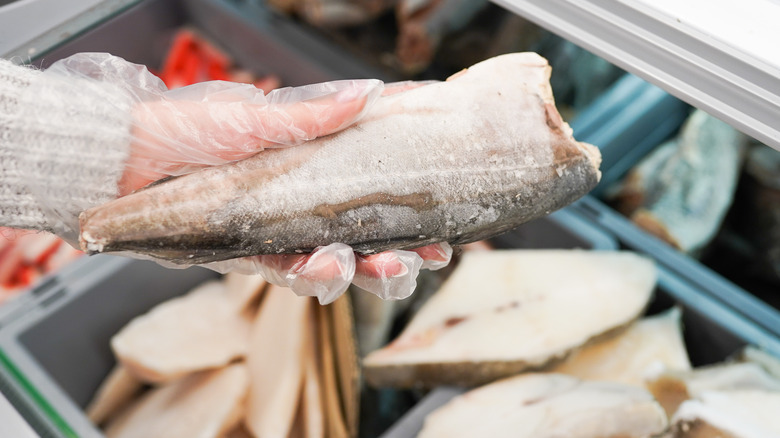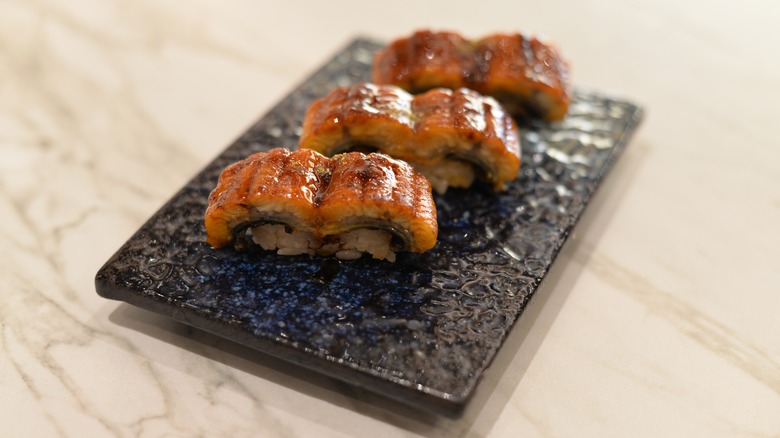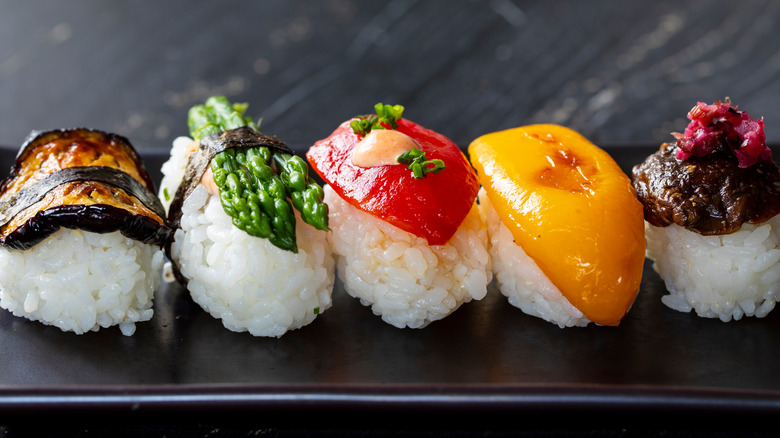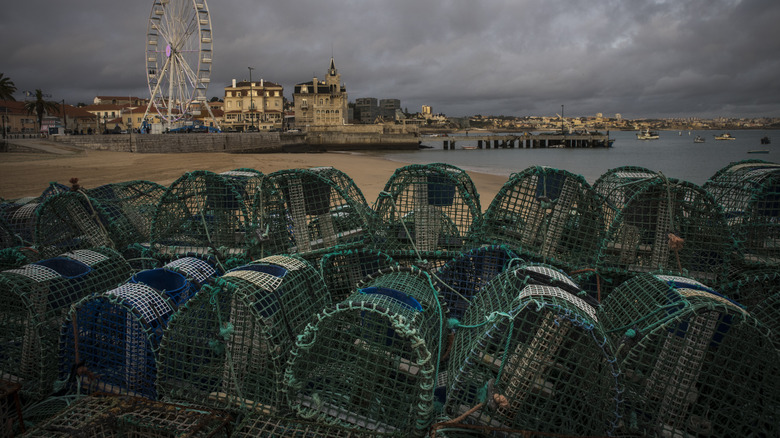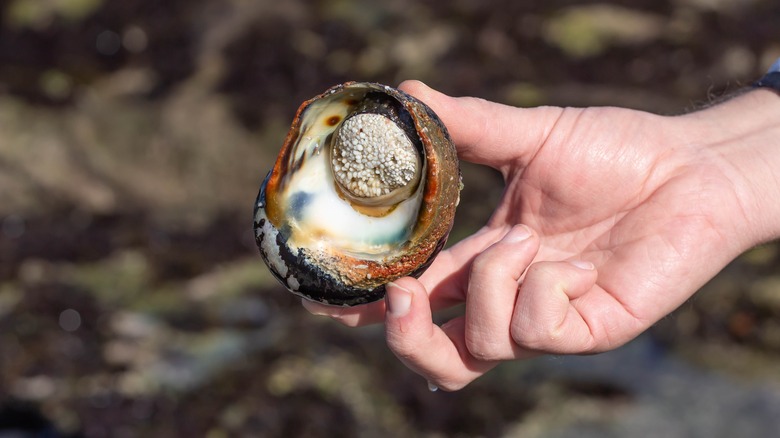14 Things You Should Know About Sustainable Sushi
Since the 1960s, our global seafood consumption has increased by 228%. Growing concerns over the future of our oceans are pushing chefs and consumers to reconsider their relationships with seafood. Though sushi is a rice-based dish, it's synonymous with fish, and the number of sushi restaurants in the United States has increased an average of 4% each year since 2018. Many of these restaurants rely on the same few varieties of seafood to satisfy their clientele and sustain their businesses, but some chefs are pushing back on the norm.
At Sozai, a sustainable sushi restaurant in Metro Detroit, Chef and Owner Hajime Sato only works with a select few varieties of seafood. This past year, Sato was one of five chefs nominated for the James Beard Award for "Outstanding Chef" for his work in sustainable sushi, though he thinks this distinction is silly. ("There should be no 'sustainable sushi chef,'" says Sato. "It should all be sustainable.") We sat down with Sato to discuss what he thinks diners should know about the sustainable sushi trend and whether or not he believes it's possible to operate more restaurants like his. (Spoiler alert: Sato knows it's not only possible but necessary, though he's candid about the hard road ahead for aspiring proprietors.)
Sustainable sushi is not regulated
The term "sustainable" has lost credibility due to greenwashing, a common marketing tactic. Unlike "organic," which the USDA regulates, any business can slap "sustainable" in front of its offerings without legal recourse. "Some sushi restaurants will claim they're sustainable when they haven't changed their practices. ... It's all marketing," says Sato.
So what are the best sustainable seafood Sato and others consider "sustainable" enough to bring into their kitchens? Turns out no single species of fish is inherently more "sustainable" than another. Instead, sustainable sushi restauranteurs look to the fishery to answer this question. Several factors influence the sustainability of the fishery, like the type of equipment and the stability of the ecosystem. Fisheries also have a responsibility to respond appropriately to environmental changes that could impact their intended catch. Though some species are notoriously overfished, evaluating "stocks" (or groups) of fish is a better yardstick for measuring sustainability than evaluating them only at a species level.
The sustainable sushi movement is regressing
According to Sato, his sustainable sushi restaurant contemporaries are in decline, largely because their chefs have thrown in the towel. "Fifteen years ago, there were more sustainable sushi bars. It's less now, much less. Because it's really hard," says Sato. According to Casson Trenor, the author of the book "Sustainable Sushi: A Guide to Saving the Oceans One Bite at a Time," as reported in the The Seattle Times, the movement has died down since sushi restaurants began operating in this way in the late 2000s. A lack of consensus around a unifying philosophy is partially to blame for the movement's diffusion: Some thought sustainable meant "vegan," like NYC's Beyond Sushi, while others relied on seafood supplier certifications to bolster their claims of sustainability. Yet all chefs endure continuous, painstaking education and re-education. "There were some legit people. It was so small. They gave up. It's too hard," says Sato.
Sato was personally disappointed with the film Seaspiracy, which claims that sustainable fishing doesn't exist despite organizations actively supporting such ends. Though the film may have highlighted the dire circumstances of the ocean's fish populations, it also breeds confusion and mistrust in anyone or anything working to create and promote sustainable fishing practices. This runs the risk of disengaging consumers from the movement and disenchanting consumers from believing more sustainable seafood dining options — like Sato's — exist.
Certification programs exist for fisheries
The Marine Stewardship Council is the largest international organization for certifying wild-caught fisheries that follow sustainable practices. (The ASC, or Aquaculture Stewardship Council, is a separate organization for certifying farm-raised fish.) To meet certification requirements, fisheries must uphold certain standards — like ensuring their catch is not endangered. While the MSC is aware that there is no such thing as a perfectly sustainable fishery — an impossible goal — Sato is still skeptical that certification is the only solution to our oceanic crisis. "While there are certification programs, you can't say overall that the fish is 'sustainable' – and the parameters [for certification] change all the time, so they're hard to follow."
Obtaining certification requires following rigorous procedures that are expensive and time-consuming to conduct, many of which require a backlog of data and ample financial resources, limiting small fisheries in particular from gaining licensure. In 2021, only 18% of small fisheries obtained an MSC license, despite the many that are well-managed. However, organizations like the MSC are taking measures to ensure the small fish aren't excluded from the bigger sustainability pond: Since 2020, the MSC has been providing grants to fund fishery improvement projects in small-scale and developing country fisheries through their Ocean Stewardship Fund.
Consumer demand impacts the movement the most
From chef to supplier, no agent in the seafood supply chain is more important in determining which kinds of seafood, sustainable or otherwise, end up on the diner's geta than the diners themselves. You've probably grown to expect the same few varieties of fish appearing on a sushi menu, like hamachi (yellowtail), ahi (bluefin tuna), and unagi (eel), without giving their sourcing much thought. Consumer demand for the same few fish species puts pressure on chefs and suppliers to deliver at any cost. "Everybody wants to consume the same fish — that's the problem. [Consumers] expect me to have yellowtail and bluefin tuna and the six or seven fish that they know," says Sato.
Of course, suppliers can limit what they supply, and some, like those who are a part of Sea Pact, have agreed to do just that. Ultimately, though, distributors and restaurants alike need to meet a certain public demand, which requires servicing an appetite that hasn't caught up with the reality that sushi can no longer be excluded from the sustainability zeitgeist.
Fish traceability is crucial
When it comes to ensuring sushi is sustainable, "traceability is more important than anything else," says Sato. "If you cannot trace [a fish back] to learn what it is, then you cannot say whether it's sustainable or not." To reduce their workloads, many sushi chefs source their seafood through distributors versus single suppliers. However, many distributors can't afford to work with only sustainable fisheries, especially if those fisheries are small. The sustainability of the fish sourced can become dubious at best. "I do have to trust the distributor to a point because I can't verify every single fish," Sato laments.
Sato consults several different organizations to evaluate his fish, like the Monterey Bay Aquarium's Seafood Watch and the National Oceanic and Atmospheric Administration (NOAA). For those looking to make sushi at home, Sato recommends following Seafood Watch ("There's an app you can download") while also cross-referencing various sources to be sure. Regardless of where you're finding your information, Sato emphasizes that sustainability starts at the level of the fishery, not the fish: "If I know of a really good [fishing] practice in Chile, then I might get [that particular fish] from Chile."
You'll need to bring a local and a global mindset to the table
You might think that the easiest way for chefs to ensure the sustainability of the seafood is simply by sourcing what's local. (Sato, who relocated from Seattle, now knows his way around the Great Lakes.) However, having a full picture of sustainability requires thinking both locally and globally. Fisheries in the United States are well-managed compared to many across the globe. However, current estimates put the United States at around 60% of exported fish to meet our total seafood consumption. Some estimates predict that it's even higher — around 90%. (The difference in estimates is due to several factors, namely unreported catches, and fish that are re-imported after overseas processing.)
While keeping things local could cut back on carbon emissions, globalization is critical to our economy — and it would be difficult to be successful in the Midwest as a sushi restaurant by offering local varieties of fish only. "How local can I go? Of course, I think about it ... you have to think big and small at the same time," says Sato. Though sustainable sushi chefs will utilize local fish — especially lake and river fish — these are generally not the only species on their menu, and most others require thinking about sustainability globally. "You have to think about how fish are caught between Holland and England because that fish might go around [the world] and come back over here."
Restaurants tend to be omakase-style
One of the ways sustainable sushi chefs can regain control of diners' appetites is by restricting what they can order. "I cannot have the same fish [on my menu] over and over — that's why my restaurant had to be more omakase-heavy," says Sato. The omakase menu, which translates to "leave it to the chef," undercuts a kind of Newton's-first-law of sushi dining: Instead of diners picking the same few rolls out of inertia alone, chefs select and serve only what's most delicious (or most sustainable), exposing diners to the possibility of sushi beyond tuna.
Engineering a successful omakase menu requires balancing sustainability with familiarity. Sato creatively meets (or exceeds) his diners' expectations by offering traditional rolls prepared using more sustainable seafood. "Sushi can be scary. People ask me if I have a California roll, and I say no. That's why we have a 'Pure Michigan' roll with cooked walleye ... instead of the fake crab." For diners seeking out rare but ultimately unsustainable fish for the luxury of it alone, Omakase offers a cultural cache that Sato uses to his advantage: "If I put the liver of the fish or the sperm sac of the fish [on the menu], do you think people are going to order it? No. But if it's part of the omakase, now it's kind of fancy ... then surprisingly, they might like it," says Sato.
You're unlikely to find bluefin or super white tuna
If you're trying to determine the ethics of a sushi restaurant, simply take a peek at their sushi list. Though some fish with poor reputations can still be harvested sustainably, other species are notoriously overfished. Sato disavows the much-lauded bluefin tuna, going so far as not putting it on his menu. So, is tuna a sustainable seafood or not? That depends. Many of the most popular tuna species are at risk of becoming endangered, and those that are not threatened are fished using methods that result in excessive amounts of by-catch.
Then other species of fish are just plain bad for your health. Take escolar, a fish that's on sushi menus under the pseudonym "Super White Tuna." Escolar contains a toxic fat that can cause severe gastric distress if ingested in even moderate amounts. "It's banned in Japan and most European countries because it contains a waxy substance called [gempylotoxin] and we cannot digest it. It's legal [in the United States] because fisheries push it and it's cheap," says Sato. While it may be legal in the U.S., the U.S. Food and Drug Administration still warns proprietors against putting the fish on their menus, though not all comply. In 2009, a study conducted by Columbia University and the American Museum of Natural History analyzed nine dishes billing themselves as "white tuna" at sushi restaurants across Denver and New York City and found that five of these were escolar.
Prepare to see smaller, oiler fish on the menu
Before big saltwater fish like tuna became fashionable, sushi was mostly made with smaller freshwater fish that were easier for fishermen to catch, like catfish, carp, and freshwater bass. Pelagic ocean fish like mackerel, herring, and sardines inhabit shallow and sunlit ocean waters, reproducing quickly. Saltwater fish like these are more plentiful than big tuna and salmon and thus more resistant to overfishing. Since they're lower on the food chain, pelagic fish require fewer resources to yield the same quantity of protein as fish species higher up on the food chain.
Sato agrees that these fish are a welcome addition to his omakase. "Trout's good, mackerel's great. ... So many people want to be eating seven or eight different kinds of fish, but we should be expanding beyond [those] and including fish that don't have much of a name — trout, sardines, mackerel ... fish that are smaller and 'fishier.' Whatever that is, we should be eating those." However, even the little guys can be fished in such a way that they are not considered sustainable, and each stock needs to be assessed independently to determine whether or not it's a sustainable choice to enjoy.
The fish was likely once frozen – and that's a good thing
"Everybody thinks that fresh fish is better, but freezing technology is really good," says Sato. Today, much of the seafood sold in sushi restaurants has been flash-frozen, which means the fish's temperature is immediately reduced to -40 to -60 C after the fish has been caught. This rapid freezing technology ensures the integrity of the protein post-thaw, avoiding the mushiness generally associated with common frozen products such as vegetables. Not only are flash-frozen fish delectable, but they're economical and sustainable, too. Fresh fish requires the fish to be shipped as quickly as possible — by plane — while frozen fish can take a more leisurely and less carbon-heavy journey by boat, train, or truck to get to your plate.
Consumer research echoes Sato's sentiments — that the term "freshness" is the highest-ranking consideration for people buying fish, despite much of the fish sold in grocery having been previously frozen and labeled as such. "I always say: What if the fisherman caught this fish in the boat [and didn't freeze it]? It might take two weeks to get here, and it's not frozen. Or there is a processing plant that's right by the fisherman, and they freeze it at -60˚C right by the fishery. Which one do you think is fresher?" Doing away with frozen fish's bad reputation can also expand the possibility of offering sustainable sushi menus across seasons. "There's a lot of seasonality in the fish. So there's kind of a balance on using frozen fish that's more sustainable and caught in a certain way so that it can kind of give you a more steady supply," says Sato.
Unagi is rarely a sustainable choice
One of the most vulnerable species of sushi fish is eel. Called unagi when prepared as sushi, according to Sato, "It's one of the worst things you can be eating right now." Climate change patterns like El Niño are affecting the Pacific Ocean and the currents that carry eel, impacting their spawning sites. Pollution and overfishing have also depleted eel stocks. Eels are also notoriously difficult to farm, as their breeding patterns remain a mystery, even to scientists, prompting the ancient Greek philosopher Aristotle to conclude that eels must emerge "spontaneously" in mud.
In 2014, Japanese eel was classified as an endangered species by the International Union for Conservation of Nature. "[Eel populations] are collapsing to the point where some scientists might say that they're extinct, not even endangered — but yet, you can still get it." How they're still accessible may be due to the black market spurred by their extremely limited stock: In Japan, environmental groups estimate that upwards of 40% of eels consumed in Japan are raised illegally. Sato worries that the rarity of the eel will only make it appear more luxurious to diners, but restoring the eel population will require a collective effort. "If one restaurant, like here, doesn't have eel, it's not going to save the eel population, but if the entire population [stops eating eel] ... that might make the eel population go back up," says Sato.
Plant-based sushi is emergent
We've seen it happen with beef. Now seafood is going "plant-based" too, with products made from legumes and vegetables calling themselves "fish". Ocean Hugger Foods has keyed in on two of the most at-risk sushi fish — Atlantic bluefin tuna and eel, creating plant-based "texture-driven" alternatives that sub in for the real thing. "Ahimi" is a tomato-based alternative to raw ahi tuna made from tomatoes, gluten-free soy sauce, sugar, and sesame oil, while "Unami" is a similarly soy-flavored but made from eggplant instead of tomato. Sato is dubious of plant-based alternatives like these, questioning their role in overthrowing an unsustainable market if they potentially replace it for another: "Plant-based is heavily processed ... and all of the nutrition is not there. You might as well eat Doritos and call it a day." The unagi this plant-based brand emulates closely mimics nasu nigiri: eggplant sushi that's been a part of the dish's history much longer than Ocean Hugger has.
There are traditional types of sushi rolls that don't contain any raw fish: Kappa (cucumber), shinko (pickled radish), and kampyo (made with dried gourd) nigiri are inherently vegetarian. "I love vegetable sushi. If you go back to my grandma's cooking ... it was all [made with] vegetables because we couldn't afford to buy fish." Sato's philosophy on eating sustainability remains simple: Reduce protein consumption and eat more vegetables. "Don't do fake tuna, fake this, fake that. ... What's the point?"
Sustainable sushi means utilizing by-catch
Despite our best efforts to fish without disrupting neighboring ecosystems, by-catch or unintended catch is still a frustrating and tragic reality of fishery — partly because of what it means for the fish and partly what it could mean for addressing widespread hunger with the right systems in place. Says Sato, "If I could distribute the entire by-catch of [salmon] processing plants, I could feed the entire world. But you can't. Because it's all about efficiency, processing, how are we going to make money?"
Most by-catch is thrown away because there aren't adequate systems set up to create a market for it, but chefs like Sato are looking for ways to buy it back. For Sato, part of building a sustainable sushi restaurant means taking a closer look at all the seafood that comes into contact with his supplier's catch — even the unintended ones — by painstakingly building bridges between stakeholders. "It took me eight years to get about 20,000 [by-catch] octopus distributed. 'Hey, shrimping guys, you can go talk to those guys. They can box it and make products out of it.' That supply chain took me eight years [to build]."
Some chefs are utilizing invasive species
Another sustainable source of protein for sushi is invasive species. These non-native fish, like lionfish, zebra mussels, and periwinkles, cause environmental and economic harm to their habitats — a boon for chefs looking to create dishes with more than one bottom line. However, sourcing these species can be difficult, as supply chains are not set up for them. "To source them, you need [many] restaurants that want to buy them so that they're economically viable for the fisherman to catch. ... Again, it fails at a supply chain [level]," says Sato. Instead, chefs have to forage for these species themselves. "People talk about it all the time – we should be eating [invasive species]. Okay, great. But I don't have time to go the Great Lakes to catch all of the goldfish and come back."
On Sato's wishlist are the blue catfish and jumbo feral goldfish that invade the Great Lakes and the aforementioned lionfish, which is difficult to catch because it lives in reefs. When asked if there are trade-offs to flavor, Sato says, yes, these species can be more difficult to work with, but ultimately, he won't know until he gives them a taste: "Can I at least get them so that I can say that they're horrible?"
